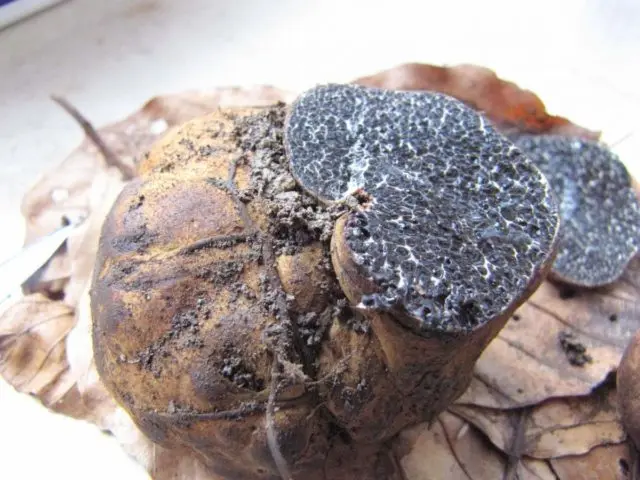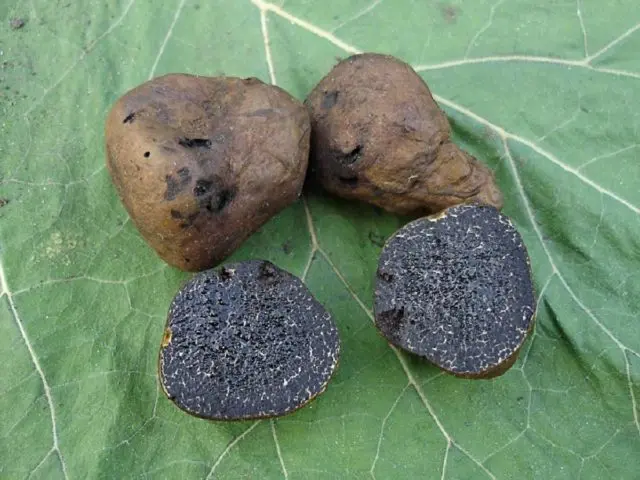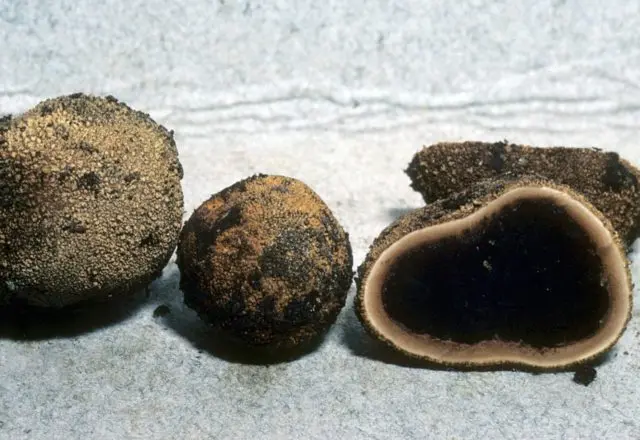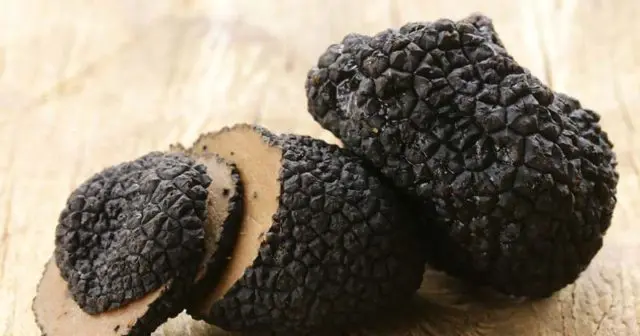Contents
False truffle, or Melanogaster Bruma, is a mushroom belonging to the Pig family. It owes its name to an English mycologist who lived in the 19th century. Is inedible. This species has nothing to do with truffles, since it belongs to a completely different taxon. His closest relatives are pigs.
What do false truffle mushrooms look like?
It is a spherical tuber with a diameter of 1 to 8 cm. Often there are “tubers” of irregular shape. Relatively soft to the touch. When compressed, they quickly restore their original shape. A photo of a false truffle is shown below:

The section shows a characteristic cellular structure.
The outer shell, or peridium, in young mushrooms looks like a potato skin. Its color may be yellow or brown-yellow. As it grows, it changes to a darker one. Older specimens may even turn black. The peridium is usually smooth, but there are also species covered with a mesh texture. In some cases, the peridium may be felty.
The inner part of the fruiting body, also called “gleba”, has a gelatinous consistency. However, it is quite resilient. In young specimens, its color is light brown. It darkens with age, becoming first dark brown and then completely black.

Whole and cut false twin tubers
Gleba is a kind of sponge, the cavities of which are filled with a gelatinous substance. The layers inside can be white, yellow or gray.
One of the features of the false twin is its rather pleasant smell, which has fruity notes. It also often confuses inexperienced mushroom pickers who mistake it for the real thing.
In addition, false truffle is often understood as another type of mushroom – deer truffle or parga. This is a representative of another family – Elafomycetes. It also has nothing to do with edible mushrooms.

A distinctive feature of parga is the granular structure of peridium
The mushroom got its name because deer and other animals, such as squirrels and hares, eat it with pleasure. Its fruiting bodies have a diameter of up to 15 cm and are located in the upper layers of the soil.
Where mushrooms grow like truffles
The range of the toadstool truffle is very extensive. The fungus can be found in many regions of Europe and Asia, as well as in North America. In Our Country, it is especially abundant in the Novosibirsk region, in Kazakhstan it grows in the Almaty region.
It prefers deciduous forests with acidic and neutral soils. Rarely found in mixed. In coniferous forests, populations of this species are extremely rare (the exception is the previously mentioned Novosibirsk).
Unlike its expensive and edible namesake, which grows deep underground, this species forms fruiting bodies exclusively in the upper layers of the soil. Often it can be found right on the ground under a layer of fallen leaves. Mushrooms are distinguished by early ripening – the first specimens appear already in early June. By mid-July, fruiting ends, and the mycelium no longer forms new specimens.
The deer truffle is much more widespread than the false one. It is found almost everywhere from the tropics to the subarctic.
Is it possible to eat false truffles
Formally, the false truffle is not a deadly poisonous mushroom. But you can’t eat it. Its taste is unpleasant, and even in small quantities it can cause serious distress. The use of a large amount of such a “delicacy” will cause serious food poisoning. In addition, there are not many who want to eat gleba, even after processing, because of its appearance.
How to distinguish false truffles
The main difference between the original mushroom and its false counterparts is the aroma and taste. But even without gastronomic experiments, it is possible to establish the belonging of a mushroom to a particular species without problems.
The main difference is that black or white truffles, which are eaten, form deep (up to 50 cm to 1 m) underground, and all false twins bear fruit exclusively on the soil surface. In addition, the mushrooms that are eaten are hard, and their inedible counterparts can be easily deformed with the fingers.

The original truffle has a solid body and coarse-grained peridium
Conclusion
The false truffle is an inedible mushroom that can sometimes be confused with the original black or white truffle due to its smell. In fact, this species even belongs to another family. A false double is not eaten because it has a very unpleasant taste and in large quantities causes serious gastrointestinal disorders.









